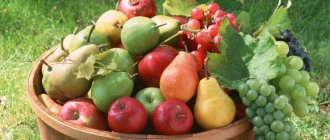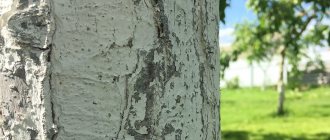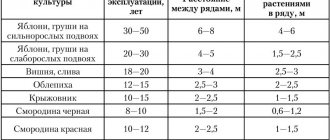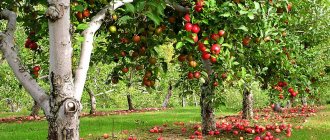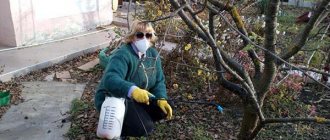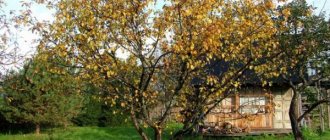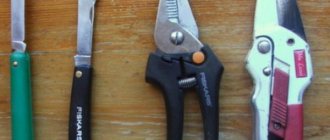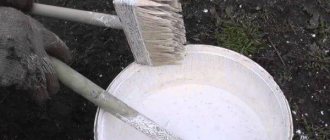Crown formation: the need for
Fruit-bearing crops planted in your own garden or plot, next to and around the house, require comprehensive and regular care. Simple and uncomplicated agricultural technology assumes that the owner of the garden plot will carry out the correct pruning of fruit trees necessary to achieve the following goals:
- regulation of growth and volumes of fruiting;
- improving the quality of the resulting fruits with increasing yields;
- optimization and improvement of crown illumination;
- rejuvenation of the plant and removal of old or diseased shoots.
It is important to include not only crown formation procedures in the complex for caring for fruit crops, but also soil care and the implementation of pest control measures.
To regulate the growth and development of trees, gardeners recommend using not only pruning, but also twisting and tying technologies, changing the direction of branch growth.
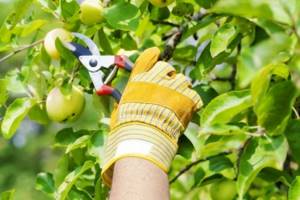
Features of pruning fruit trees
Grafting trees in spring, methods of grafting fruit trees for beginners
Fruit trees are pruned in any season except winter: during the cold season they go dormant. The timing of pruning depends on the specific region. In the northern and central regions of Russia, branches are not shortened in the fall. In these places, the cold comes early, and the trees do not have time to heal their wounds. It is recommended to start pruning in these regions in the spring, after waiting for above-zero temperatures. The procedure must be completed before the buds open on the trees.
Important! Professional gardeners prefer to prune trees in the spring so that they can fully recover during the summer-autumn period.
When and which trees in the garden can be pruned?
In order not to harm the future harvest, it is important to know when to prune a tree. Pear and apple trees are the first to be pruned in the garden, as these trees are characterized by frost resistance. It is recommended to shorten some fruit crops only after leaves appear on the branches, otherwise the cuts may become covered with a fungal coating. These include cherry plum, plum, apricot, sweet cherry and sour cherry.
Some shrubs (for example, climbing roses and lilacs) produce flowers on last year's shoots, so it is not recommended to prune them.
At what age should fruit trees be pruned?
In summer, branches are pruned from plants older than 3 years in order to improve the quality of the fruit. After this procedure, rapid development of young shoots begins. The advantages of summer pruning include life-giving juice, thanks to which wounds heal quickly.
In the south of the country, gardeners perform winter pruning of such trees to reduce the yield of young seedlings. After 3 years of fruiting, they are allowed to rest. Pome trees are pruned first, and then stone fruits.
A tree that is more than 10 years old needs rejuvenating pruning. It is made at any time of the year, but better in the spring. Formative spring pruning begins in the second year after planting.
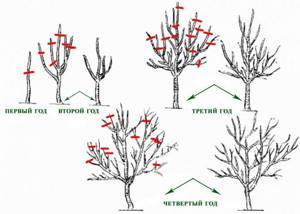
Pruning seedlings by year
How to prune a seedling correctly to get more yield
When pruning a young seedling, its trunk is first formed: all branches located at a distance of 40 cm from the ground are removed. Next, determine the main 3 - 4 strong branches that will become the skeleton of the crown. All other branches are removed with a “ring” cut.
The remaining branches are trimmed so that their ends are at the same level. They should develop evenly and equally. It is important to consider the location of the bud near which the cut is made. If it is on the outside of the pruned branch, the young shoot will grow in the same direction. If the bud is located on the inside, the branch will grow into the center of the crown.
Important! The correct cut should be oblique and there should be no stump on it. The lower part of the cut should be slightly above the base of the bud, and the upper part should coincide with the top of the bud.
What is tree branch pruning?
Looking at the wide variety of photos of fruit tree pruning offered, you can notice the simplicity and accessibility of this method of caring for green spaces.
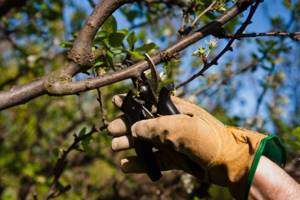
The not complicated and fairly easy procedure provides different effects, making it possible to expand the range of measures for caring for fruit-bearing crops:
- growing trees of the required size with a certain trunk strength to support large fruits;
- maintaining the best fruiting conditions for a long time with normal lighting of the branches and easy harvesting;
- timely formation of ovaries and fruits due to the correct and uniform distribution of liquid;
- compliance with the regularity and timing of fruiting under changing climatic and weather conditions.

The purpose and required results of crown formation are determined individually; they are influenced by the biological characteristics of fruit plants. Before choosing equipment and technology, the type and method of implementing agrotechnical procedures, a beginning gardener should definitely take into account the breed and variety of the cultivated plant.
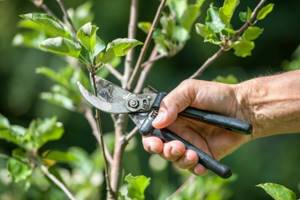
Various types of pruning
When pruning, a gardener can pursue various goals. Accordingly, there are different types of pruning.
Recent Entries
5 working ways to use tar in the garden 7 indoor plants that help you get married even in adulthood Indoor plants that can bloom in trouble
- Formative. Helps create a crown of the required density and silhouette of the tree. Thanks to it, a properly formed skeletal part becomes resistant to stress. Formative pruning in February makes regrowth more intense, and in March-April it slows down the growth process.
- Regulatory. It is necessary to preserve the formed crown, helps maintain good illumination of the branches, and prevents the skeletal part from being overloaded with young shoots. This pruning is relevant in February-April and August-September.
- Rejuvenating. Allows the old tree to renew itself as it stimulates the growth of new branches. If the annual growth of shoots is 10-15 cm, you need to shorten the branches to awaken adventitious and dormant buds. This should be done in early autumn, late winter and spring.
- Restorative. This measure allows plants that have suffered for various reasons to regain the opportunity to develop, flower and bear fruit.
- Sanitary. If there are dry, diseased, broken or damaged branches on the plant, they must be removed. This can be done all year round, but not on frosty days. After pruning diseased shoots, it is necessary to disinfect the tool with alcohol.
When performing sanitary pruning, it is necessary to take into account the size and age of the tree. Very intensive work can lead to thickening of the crown.
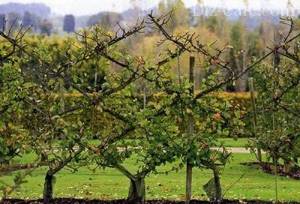
Amazing results can be achieved with pruning. For example, this trellis is formed from apple trees that have been pruned for decorative purposes.
Methods used to form trees
Caring for a garden brings a lot of pleasure to those who strive for order and set the goal of increasing the yield of fruits and berries. Modern gardeners know the two most common ways of carrying out the shortening procedure, which have their own differences and characteristics and are carried out to achieve different goals:
- shortening is pruning and partial removal of the upper parts of already formed shoots;
- thinning, cutting and complete removal of individual shoots and branches, rosettes of branches to reduce the level of crown thickening.
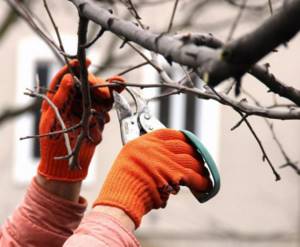
When carrying out both activities, positive changes are observed in the process of plant growth, due to the redistribution of liquid and nutrients.
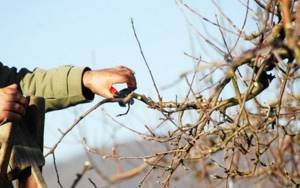
Depending on the chosen technique, intensive growth of lateral branches and shoots is caused, which contributes to the correct formation of the main branches and increases their water-conducting ability.
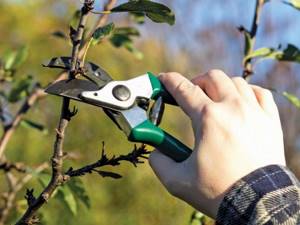
When is the best time to prune trees?
When to prune trees in order to injure them as little as possible? The best time to prune trees is from the end of January to the beginning of April, when the plants are dormant, the movement of sap in them has not yet begun and the buds on the trees have not swelled. Actually, you can carry out pruning starting in November, but there is no guarantee that frost will not hit the next day, so it is better to postpone the procedure closer to spring. As soon as the air temperature in the garden rises above -8 ºC and remains at this level for several days, you can begin formative and sanitary pruning.
Spring pruning of fruit and berry bushes in the garden
Formative pruning of a tree is carried out within five years from the moment of planting: you need to form the crown so that it is convenient to care for the tree and so that sunlight reaches the very thickest part.
In subsequent years, in early spring, sanitary pruning is carried out, the purpose of which is to remove frozen, dried out, broken, competing, damaged by pests or diseases, and sagging branches and shoots in the lower part of the crown. However, if necessary, sanitary pruning in the fall will not harm the trees.
- Cloudberry: properties, planting and care, types

Anti-aging pruning restores the slowed growth of old trees and stimulates the formation of generative buds. It is also best to carry it out at the end of winter or early spring, and rejuvenation of trees begins not when they are already old, but after the first two or three harvests or as soon as you notice a decrease in flowering.
The most famous pruning techniques for beginners
Target orientation helps you choose a technique that allows you to implement the task as accurately as possible; it is recommended that you familiarize yourself with the existing methods:
- bud cut;
- ring cut;
- side branch cut.
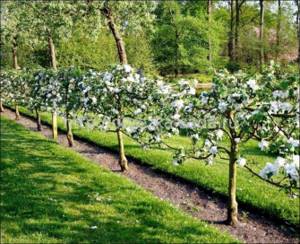
For each crop, its own timing for pruning fruit trees is selected, subject to the selection of the correct technique and type of implementation of the activity.
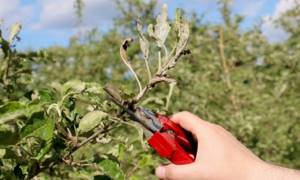
Features of winter pruning
The only limitation to pruning fruit trees in winter: it is undesirable in frost, when the wood becomes particularly fragile. Branches are easily damaged at this time, and they heal poorly. If the air temperature drops below 8 degrees below zero, pruning work should be postponed.
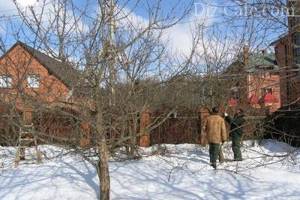
Pruning in winter has its advantages, since there are no leaves on the tree and the crown with all its defects is clearly visible
Benefits of pruning in winter:
- trees that are at rest will experience less stress;
- the cuts are better and more accurate.
The complete absence of foliage allows you to more objectively assess the condition of the crown, identify its shortcomings and draw up the correct work plan.
To shorten thick branches, you need a saw. To prevent injury to the branches due to scuffing, the branches are first sawed off from the opposite side. Thin branches are cut with pruning shears.
Timing of the procedure: how to schedule
Maintaining the fruiting function requires the mandatory formation of the crown, but the schedule for such work varies for certain crops. To ensure that each tree branch receives sufficient nutrition and the necessary lighting, different types of pruning are carried out depending on the season and climatic conditions:
- winter chasing, carried out during the dormant period of trees and necessary to prepare them for the spring season;
- spring, the most common option for garden care, helps increase productivity and improve the health of the tree;
- autumn, used for preventive and sanitary care, the technology is similar to other types of work.

Summer pruning of fruit trees is the least common practice, and can be done for decorative, sanitary and preventive purposes. In summer, vegetation processes are most active in trees, and experienced gardeners recommend not disturbing the natural conditions for the growth and development of cultivated plants.
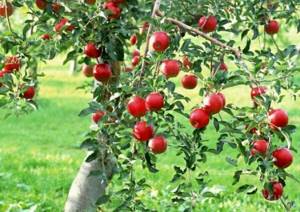
Formative winter and spring pruning of apple trees by year
To prolong the life of trees and get good harvests, formative pruning is carried out at the end of winter - beginning of spring. Over time, it is necessary to achieve such an arrangement of branches so that the upper tiers do not obscure the lower ones from the sun. The crown should consist of a central conductor (first-order branch) and skeletal branches.
Each skeletal branch should have several shoots of the second, third and fourth order. The harmonious crown has a pyramidal shape. And the older the tree, the flatter it should become. The recommended height of fruit trees for convenient fruit removal, treatment with pesticides and pruning is 3–3.5 meters.
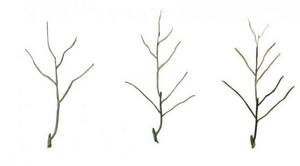
Formative pruning of an apple tree from the year of planting to the third year of cultivation
First pruning: immediately after planting
An annual apple tree seedling is a stem 120-150 cm high, without side branches. Measure 50 cm from the soil level on it - this is the future standard. It is impossible to make it lower, since the lower branches will interfere with cultivating the soil and applying fertilizers. Tall is also undesirable: it can suffer from sunburn and frost damage. There should be no branches on the trunk.
At the indicated height, find a bud that will become the lowest, the first skeletal branch of the lower tier. At a distance of 20-30 cm from above it, leave two more buds, looking in different directions. During the summer, branches will grow from them with divergence angles of about 120°. This will lay the first tier.
Above the fourth bud, the stem is cut off, leaving no stump. It should be on the opposite side of the trunk in relation to the grafting site. So that the trunk does not bend. The fourth bud will eventually become a continuation shoot.
Second pruning: late winter - early spring next year
On the continuation shoot, measure 50-60 cm up and again leave 2-3 buds located at a distance of 10-15 cm. These will be the branches of the second tier. If the length of the shoot allows, measure another 40 cm and 1-2 more buds. A cut is made above them, removing the “leader”. If the leader is not yet long enough, reschedule pruning until next year.
Third pruning: in the third year at the end of winter - beginning of spring
You should have a formed seedling with three tiers. Remove shoots from the trunk annually. Bend annual growths between tiers down to weaken their growth, but do not cut them. They are the very first to begin to bear fruit. Inexperienced gardeners sometimes cut out these shortened (20-30 cm long) branches and thereby delay the harvest. By the time formative pruning is completed, a vigorous apple tree should have 7-8 skeletal branches. Its height is usually 2.5-3 m.
Subsequent years: how to prune a mature apple tree
In the future, make sure that the ends of the branches of each tier are at the same level; strongly growing branches, exceeding 3 m in height, are removed or significantly shortened every year, leaving 1-2 buds.
Watch our detailed video on how to properly prune an apple tree in late winter - early spring
Features of crown formation in old trees
Standard autumn pruning of fruit trees requires careful attention to the age of the plants being treated.
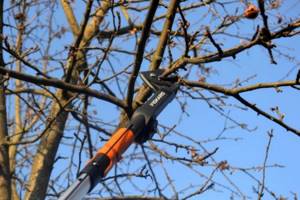
Old trees do not need to be shortened; thinning techniques are most often used for them, with pruning of entire links and branches; health procedures help to increase the level of fruiting.
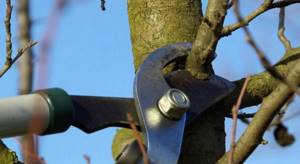
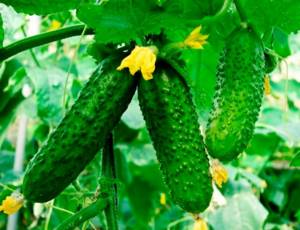
Cucumbers in the open ground - tips and secrets of growing, planting features and ways to tie them correctly (90 photos + video)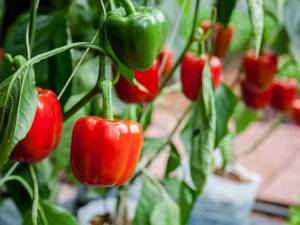
Peppers in a greenhouse: tips for growing, growing and caring for peppers in greenhouse conditions (110 photos + video)
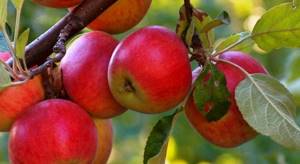
Apple varieties - how to choose the right ornamental and fruit apple trees. 100 photos of the main types of apple trees
Spring formative pruning of fruit trees with a palmette crown
There are many options when creating palmettes. Nowadays, the requirements for the formation of palmettes are, of course, simpler than before. And various variations on this theme have existed for a long time. So the choice is yours.
Spring pruning of palmette-shaped fruit trees can consist of two skeletal branches located in the same tier. It can be a candelabra - made of four or more branches. The branches can be arranged in 2 tiers, as in Verrier palmettes. A freer option is also possible, for example, Montreuil palmette. A distinctive feature of palmettes is the location of all branches in the same plane.
The easiest to shape is a simple U-shaped palmette. Everything happens in the same way as the removal of a two-armed cordon. Only the skeletal branches are first fixed horizontally on a tensioned wire, and then, at a distance of 15 cm from the trunk, they are directed upward and fixed on vertical supports. Plants in the hedge are placed at intervals of 70-80 cm.
A more complex version of formative pruning of fruit trees is the double U-shaped palmette. In this variant, each skeletal branch bifurcates again. Before making such pruning of fruit trees, it is important to pre-install a frame for all planned branches.
Palmette Verrier provides for the presence of a second tier or central conductor. This means that after the first pruning of an annual seedling, you need to leave not 2, but 3 shoots - the top one will become a continuation of the trunk. If a second tier is planned, then the lower branches are fixed horizontally for 70-80 cm in both directions and only then directed upward. The distance between tiers is 40 cm.
Candelabra palmettes are one of the more complex options.
Here you may need not only the art of shaping, but also the ability to instill. Formation begins with the establishment of a horizontal two-armed cordon: after reaching a certain length, the branches are bent upward.
Vertical shoots are formed on the branches themselves. It is important that everything is symmetrical, so if there are no shoots in the right places, it is necessary to bud grafting.
A simpler option is Montreuil palmettes.
In this case, vertical shoots on horizontal branches are chosen arbitrarily.
When forming palmettes, you need to take into account that the growth of branches will be weaker than when forming cordons. Therefore, for palmettes, more vigorous varieties are chosen, and the length of last year’s growths is left within 30-40 cm, otherwise the arrangement of overgrowing branches will not be uniform.
It is very important to ensure the uniform growth of all branches. And if the branches are weak, it is better to postpone the next stage of formation for a year.
What tools are useful for a novice gardener?
Even a novice gardener will need a certain set of tools that will help him carry out the procedure correctly and competently. Depending on the condition of the garden and the presence of trees or shrubs of a certain height and lifespan, the master may need the following specialized devices:
- manual pruning shears, when choosing such a device, it is better to avoid the presence of a ratcheting mechanism; with one press it is better to make a single cut;
- a garden hacksaw, a saber-shaped and sharp tool that helps get rid of fairly large branches without sawdust and shavings accumulating in the teeth;
- air pruner, a simple design, is a pruner on a telescopic shaft, which ensures cutting of high-lying branches.
The tools used require certain care; blades and cutting edges must be as sharp as possible and protected during storage. Before each procedure, cutting tools should be treated with disinfecting solutions, which will prevent the transmission of diseases or fungal infections to garden crops.
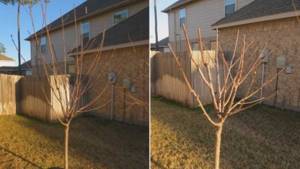
Pruning an apple tree in spring
The essence of the procedure is to form the correct crown. The first pruning of trees should be carried out immediately after planting. Saplings need to be shortened to 80-95 centimeters. Side shoots should also be shortened by a third or a quarter of the entire length of the branch. If there are no side shoots, the procedure is carried out in the spring of next year.
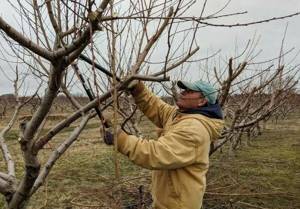
The diagram for pruning an apple tree is presented step by step in pictures. In the second and subsequent years, dry, diseased and damaged branches must be removed. Especially those that grow towards the central part of the tree. It is necessary to ensure that the side branches are not longer than the central conductor. You can learn about the principles of pruning from the video for beginners.
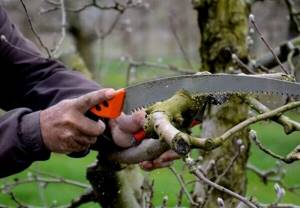
Pruning columnar apple varieties differs from the usual procedure. In this case, work should begin with large branches.
By the way!
Apple trees that are too tall should be shortened by a third of the central trunk, and a crown should be formed using side branches.
If it is clear that the main branches are non-viable and rotten, then pruning is not necessary, it will not help bring the crop back to life.
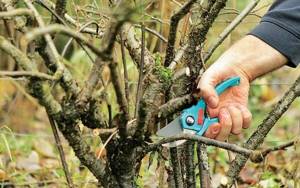
Useful tips
Tree pruning is a rather complicated operation, so experienced gardeners have identified the main points of this process, which we will share with you. So here are some helpful tips:
- Range of forest materials

How to choose the right compressor hose
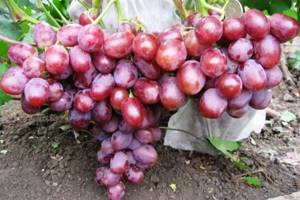
Grape varieties - the best varieties, characteristics and cultivation characteristics (75 photos)
- The branches need to be trimmed close to the tree trunk, without leaving any stumps;
- If you trim the branch correctly, you will see a trace of a neat overgrown “ring”, which is very good;
- When pruning massive branches, first you need to cut it from the bottom, and then from the top.
- Did you remove the branch incorrectly and the tree was damaged? In such a situation, you need to clean the damaged area and treat it with boiling water.
- If the tree is too frozen, it is better to leave pruning for next year.
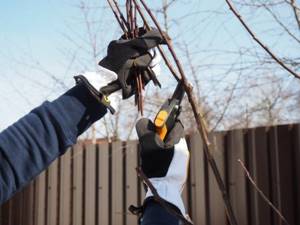
How and when to prune trees
Tree pruning. How it's done? Why is tree pruning necessary? This is what we will consider.
Pruning fruit and berry trees is a complex and responsible undertaking. If pruning is done incorrectly, this can lead to a shortening of the fruiting period, as well as a decrease in frost resistance.
Garden trees are pruned for several purposes.
Pruning to shape the plant . This type of pruning is necessary for young plants. It is aimed at regulating the crop load on each branch.
Pruning to regulate fruiting. This type of pruning is necessary for fruit trees. In this way, you can extend the fruiting period, as well as regulate the frequency of fruiting.
Pruning to improve lighting conditions. This pruning is done to reduce the canopy of trees to allow more sunlight to reach the remaining canopy. This way you can influence productivity.
Pruning to shorten nutrient pathways. Fruit and berry trees need rejuvenating and sanitary pruning. Anti-aging pruning is used to eliminate signs of tree aging. It also helps to extend the life of the plant and the period of fruiting. Trees need pruning to remove dead or dying branches so that they do not interfere with the penetration of light to fruiting branches and do not delay the process of internal circulation of nutrients.
Pruning of garden trees is usually carried out in spring and autumn . In the spring, this is done even before the leaves bloom and the process of juice movement begins. In autumn, pruning is necessary so that the trees can easily overwinter.
To increase the effect of pruning, it is necessary to properly care for the land, as well as carry out preventive measures to combat pests and various diseases.
You can regulate the growth and quantity of the crop not only by pruning trees, but also by changing the position of the branches. Pruning helps gardeners grow fruit trees of the desired height, with a strong trunk that can support the weight of the crop. If pruning is done incorrectly, the result can be a thickening of the crown, a late entry into the fruiting period, and a decrease in winter hardiness.
There are two main ways to prune fruit trees: shortening and thinning.
The more tree branches are shortened, the more the tree rejuvenates. This method of shortening stimulates shoot growth, bud development, and thickening of branches.
Thinning, i.e. Complete removal of shoots improves the flow of sunlight to the fruits, which in turn stimulates their growth and development.
Tree pruning technique
When shortening an annual shoot, you need to make an oblique cut above the bud. The bud should be on the opposite side of the cut. This shortening should be done with a garden knife or pruning shears. If the branch is very thick, you can use a saw.
When thinning, the branch must be cut into a ring. The cut should be parallel to the bevel at the base of the branch. Make sure that there is no hemp left near the swelling - this will make it difficult for the wound to heal. Also, you should not cut the branch below the ring - in this case, the wound area will be larger. If the branch is very thick, you should use a saw. After removing the branch, the cut area must be cleaned with a sharp knife so that the cut surface becomes smooth.
When should trees be pruned? Timing of pruning
In central Russia, fruit trees are best pruned in spring and summer. In spring, pruning should be done in March-April, before the trees enter the growing season.
The breed of fruit trees and their condition play an important role when pruning. You should start pruning with apple trees - the trees that are most resistant to adverse conditions. If the trees are very young (for example, planted in the previous autumn), then they must be pruned before the process of sap flow begins.
For stone fruit trees, they should be pruned before buds open.
If the trees did not survive the winter well, they look weak and damaged, then you should not rush to prune such trees.
In summer you can do pinching. This is a type of pruning in which the tips of growing shoots are removed. Pinching is usually done with fingernails, without the use of garden tools. Branches are cut with pruning shears only if most of the shoot is removed.
Pinching done at different times has different effects on trees. If you do pinching in June, when the trees are actively growing, this may have an adverse effect on the condition of the trees as a whole.
Pinching done during the period of cessation of shoot growth improves the formation of axillary buds, has a positive effect on shoot growth, and also improves fruit ripening.
The age of the trees also plays a role in pruning. At different ages, fruit trees have different patterns of growth and fruiting. When trees are young, active crown growth occurs. And in older trees, crown growth slows down, and processes associated with the formation and ripening of fruits come to the fore.
Types of tree pruning
There are several types of pruning of fruit trees. The main and most common are two of them: whorled-tiered (or five-legged) and combined.
When a whorled-tiered crown is formed, 4-5 branches remain in the lower tier of the tree. In the second tier there are 2-3 branches. There should be a distance of about 50-70 cm between the first and second tier.
In total, there should be approximately 8-12 branches on the trunk of the apple tree. It is not difficult to form the crown of a tree using a whorl-tiered system, since the choice of branches is not difficult.
❧ Under no circumstances should the crown of fruit trees be allowed to grow spontaneously. If a young tree does not form a crown from the very beginning, then in the future this may lead to the appearance of intertwining branches; the load on different branches during the ripening of the crop will be different, which will lead to the breakage of individual branches. The conductor may even break, which will accelerate the death of the tree as a whole.
The combined crown is formed differently. The lower (first) tier forms three branches, located, depending on the variety, 2-3 buds apart (about 15 cm). Sometimes gardeners leave two more branches from adjacent buds, but this is only if they grow in different directions. It happens that a spare shoot is left in the tier, which is used when one of the skeletal branches breaks.
The fourth skeletal branch is laid approximately 40 cm from the lower tier, and each subsequent one at a distance of 30-40 cm. In total, there are about 6-8 skeletal branches on the tree. In the figure, side branches 2, 6, 8 and 10 are left as skeletal branches of the first order; branches 3, 4, 5, 7, 9 and 11 are shortened by overgrowing wood; branches 1 and 12 are cut into a ring.
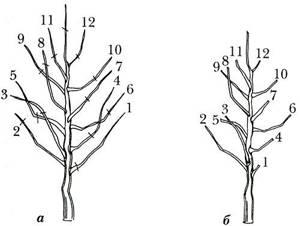
Drawing . Pruning according to a combined scheme: a - seedling before pruning (the lines show the pruning places); b - seedling after pruning
The bushy crown is suitable for those gardeners who prefer short trees.
Fruit trees with a bush-like crown reach a height of about 4 m; such trees are easy to care for, collect fruits, etc. After you have planted a seedling in your garden plot, you need to select 5-6 skeletal branches on it, the distance between them should be about 10-15 cm, and cut out the remaining shoots.
Seedlings planted in spring are pruned immediately. Annual branches are shortened by half or one third of their length, and the conductor is removed just above the last lateral branch at a time when this branch takes a stable direction of growth.
This type of crown is well suited for trees with highly branching crowns.
Young trees should be pruned every year, but sparingly, being careful not to cut or shorten large branches. If it is necessary to slow down the growth of any branches, then this should be done gradually, year after year. You should not immediately cut off the branches of the tree too much - this will negatively affect the growth and development of the crown in the future.
Different varieties of fruit trees react differently to pruning; therefore, you need to pay attention to their ability to form shoots, as well as the degree of excitability of the buds. For example, apple tree varieties can be divided into three groups according to these characteristics:
The first group includes varieties with weak excitability of the buds and low ability to form shoots (Brown striped, Korobovka, Kitayka golden rannyaya, Titovka).
Apple trees of these varieties produce long, thin branches. Their productivity is not too high. Such trees should be heavily pruned, i.e. trim from 1/2 to 2/3 of the shoots. This pruning will ensure good branching and thickening of the branches, which in turn will lead to the formation of a large number of fruits.
Young trees have strong one-year-old shoots about 70 cm long, moderately growing ones - up to 35 cm. Strong shoots are shortened to 40-50 cm, and moderate ones are left as is.
Many pear varieties also have poor shoot formation abilities. As a rule, the terminal shoots grow strongly, forming ankle branches. Therefore, pears are pruned in the same way as apple trees of the first group.
The second group includes trees with good excitability of the buds and weak shoot-forming ability (Grushovka Moskovskaya, Arkad yellow, Borovinka). These apple trees have moderate branching and abundant production of short fruit formations. Apple trees of these varieties usually have periodic fruiting.
Such trees need to be pruned moderately - by 1/2-1/3 of the length of annual shoots. This type of pruning will ensure the emergence of growth shoots and also enhance the development of weak fruit branches.
The third group includes varieties with high bud excitability and good shoot-forming ability (Osennee Polosatoe, Suislepskoe, Antonovka, Melba, Pepin Saffron, Riga Dove, Anis). All trees of these varieties have good branching and a high level of fruiting. When pruning shoots on trees of these varieties, you should be careful not to shorten the shoots too much. It is better to thin out shoots growing inside the crown, since it often happens that shoots of trees of these varieties can intertwine with each other.
Old trees need to be pruned to prolong their life and fruit production. If the trees are very neglected and have not been pruned for a long time, then it is recommended to immediately carry out a strong rejuvenation. The branches of such trees are shortened by 1/2-2/3 of the length, which is from 0.5 to 2 m from their top. Branches should not be cut back more than 2 m, as this can lead to the death of the trees.
Pruning must be done above a growth shoot or fruit branch. The cut branches should not be left completely bare. If the tree has dying branches with spiky shoots on the lower parts, then such branches need to be cut back to these sprouts.
When rejuvenating trees, it is necessary to generously fertilize the soil under the rejuvenated trees in the spring. This is done in order to stimulate the active growth of new shoots in the first year after pruning.
After the old trees, after rejuvenation, give abundant growth of new shoots, it is necessary to cut out all the stumps and cover the cut areas with oil paint.
It is better to extend the process of rejuvenation of old trees over two years. In the first year, trim the upper branches, and in the second - the lower ones. In this case, the upper branches should be trimmed more than the lower ones. The upper branches are cut by 2/3, the middle ones by 1/2, and the lower ones by 1/3 of their length.
If pruning of old fruit trees is carried out according to all the rules, then soon the rejuvenated trees will quickly grow, begin to bear fruit and will produce a rich harvest for about 10 years.
Stone fruit trees are early bearing fruit. In this regard, their crown forms much faster than that of apple or pear trees. The entire crown of stone fruit trees is formed within 5-6 years. Such trees are also pruned, as it helps the tree to develop faster. But when pruning stone fruit trees, you must carefully ensure that they grow on fertilized soil. Pruning carried out in a poor agricultural background can cause disease in trees and stunt growth.
❧ An interesting and complex process is olive pruning. It is carried out after harvesting the fruits. It is important to correctly determine which branches need to be pruned, since fruits form only on two-year-old branches. To prune the olive tree, a specialist is invited - an “olive trimmer”, who prunes the trees. Often the crowns of olive trees are cup-shaped. This way the sun's rays can freely penetrate to every branch of the tree.
Cherry and plum trees are pruned according to a combined or bush pattern. Branches are placed on the trunk singly or in groups of 2-3. Between branches in tiers there should be a distance of 8-10 cm, between groups - 25-35 cm. Mature trees should have 8-15 branches. On first-order branches, second-order branches are placed at a distance of 20-30 cm from each other, trying to ensure that the secondary branches are located on both sides of the skeletal branch.
Young seedlings in the first year after planting (pruned according to the general rules for pruning fruit trees. Skeletal branches must be shortened, and the top of the conductor should be 15-25 cm higher than the tops of the upper lateral branches.
Proper and timely pruning of fruit trees prevents the occurrence of many problems that appear during the growth and fruiting period of the tree. It is extremely important to determine the need for pruning in a timely manner. If pruning is carried out according to all the rules, it means that the trees in your garden plot will live a long time and bring a rich harvest.
We recommend watching:
Tree crown formation
Pruning trees and shrubs
Growing pear
Growing apple trees
Pruning calendar for fruit trees and shrubs
